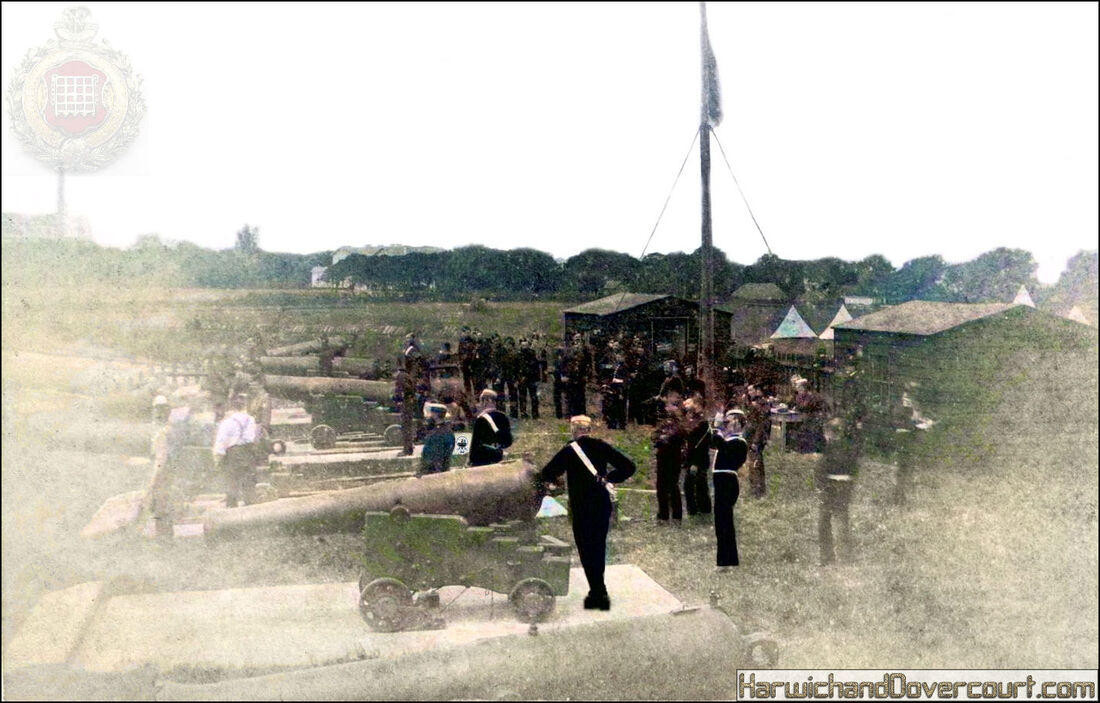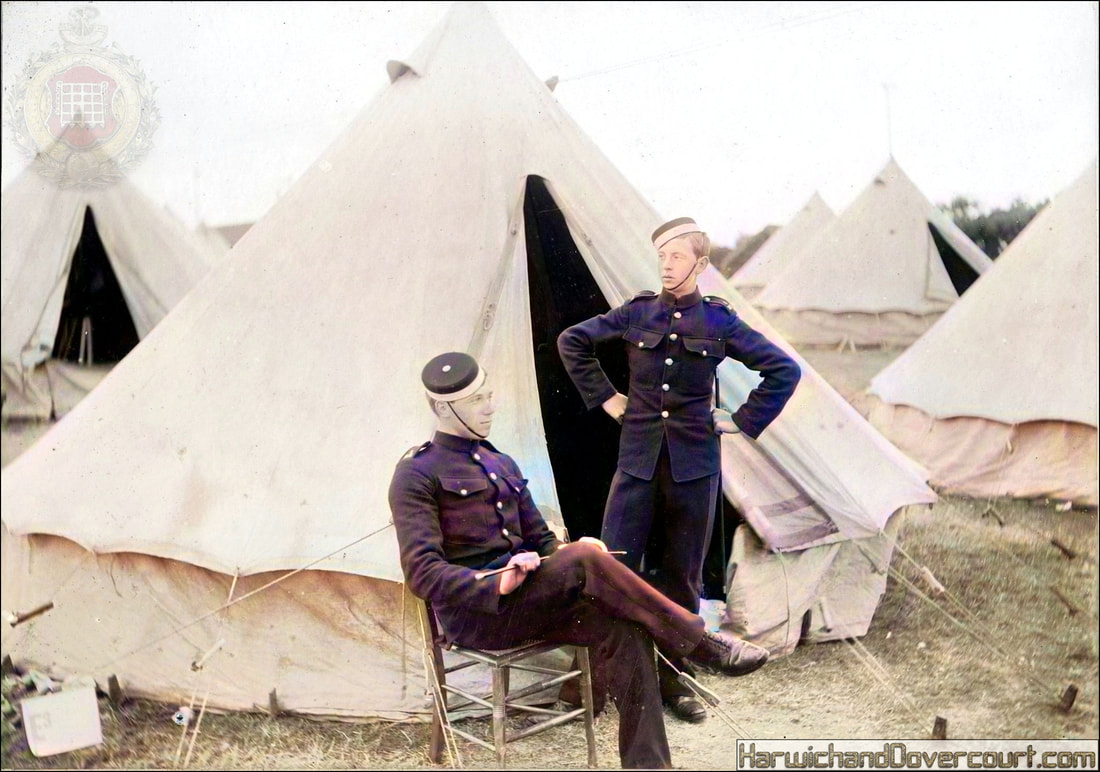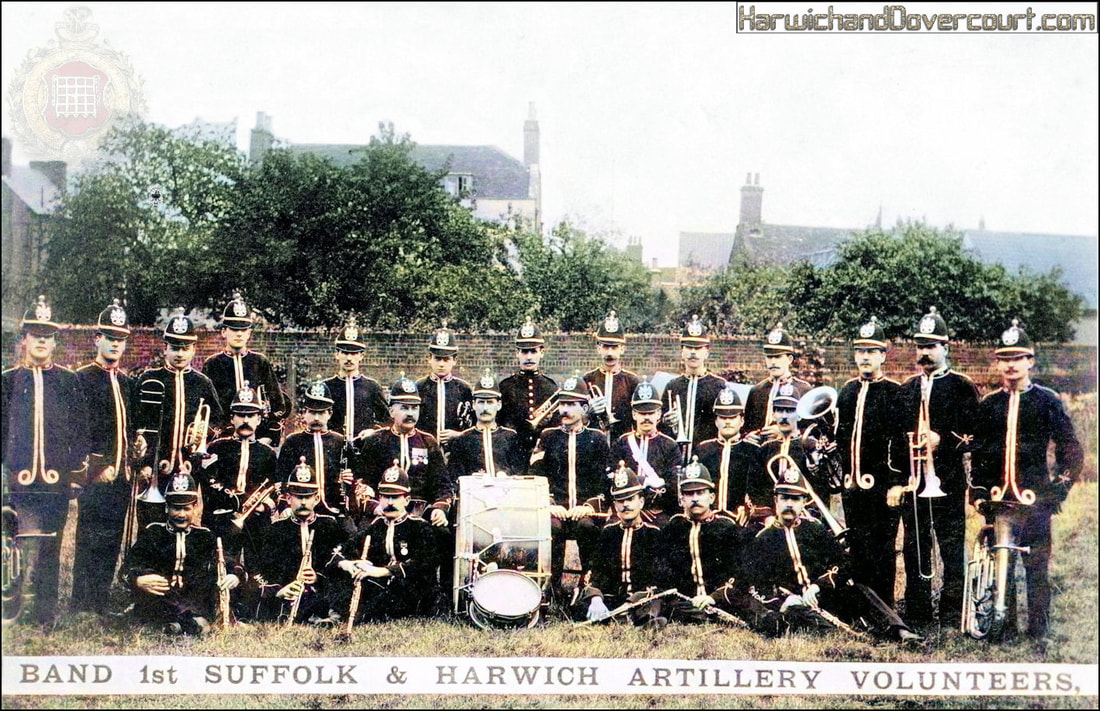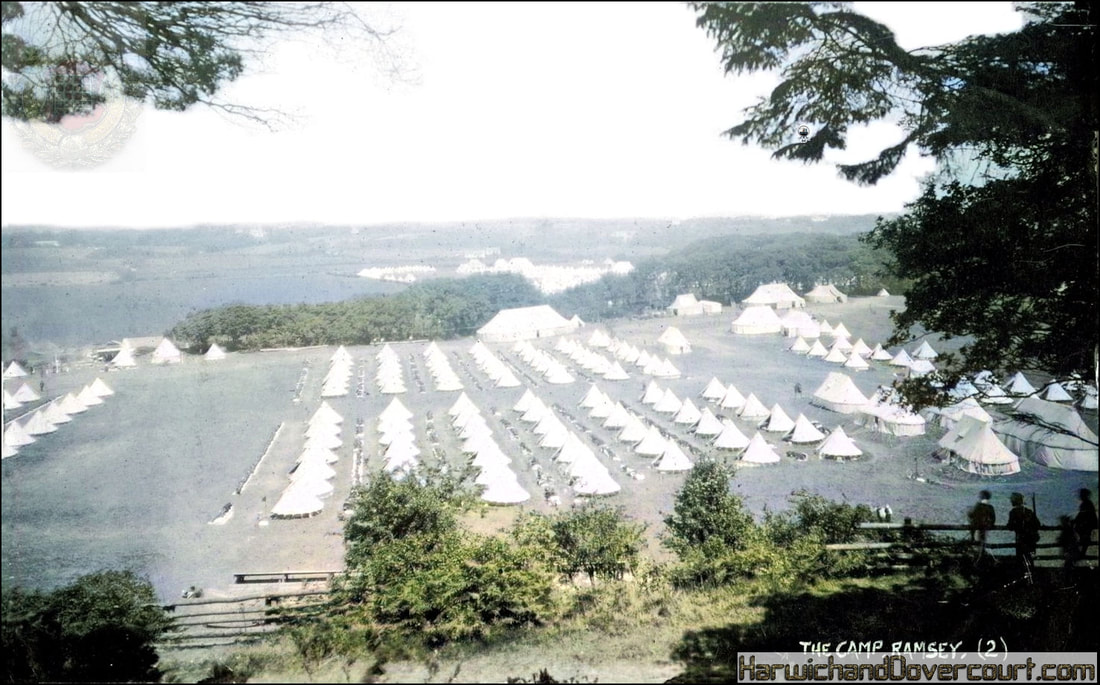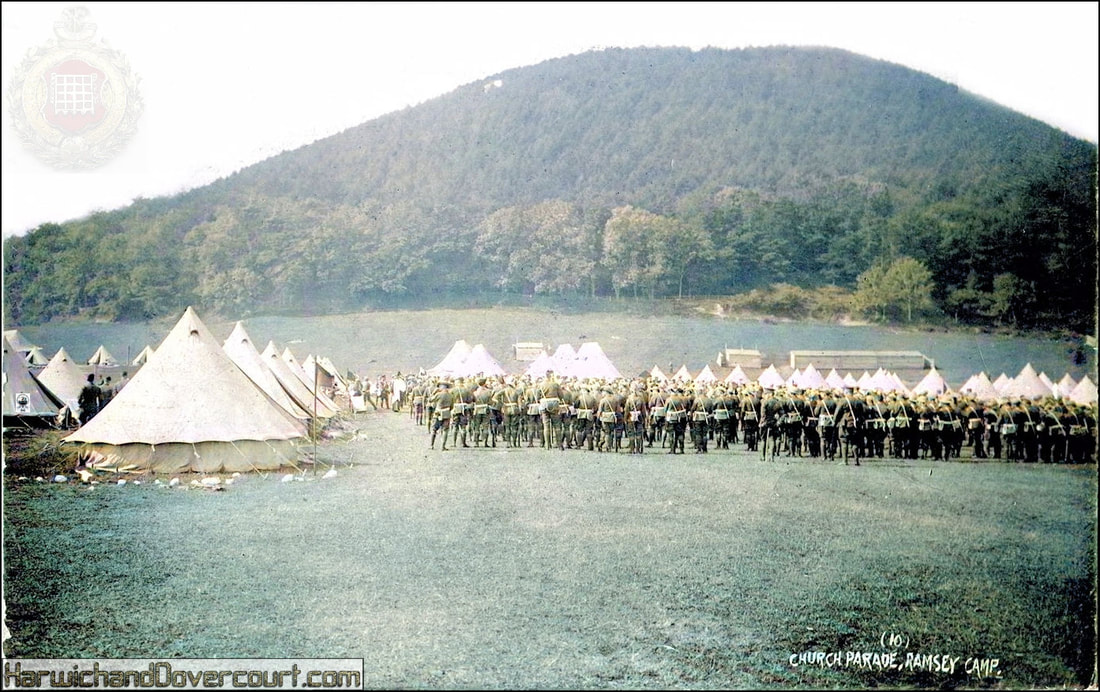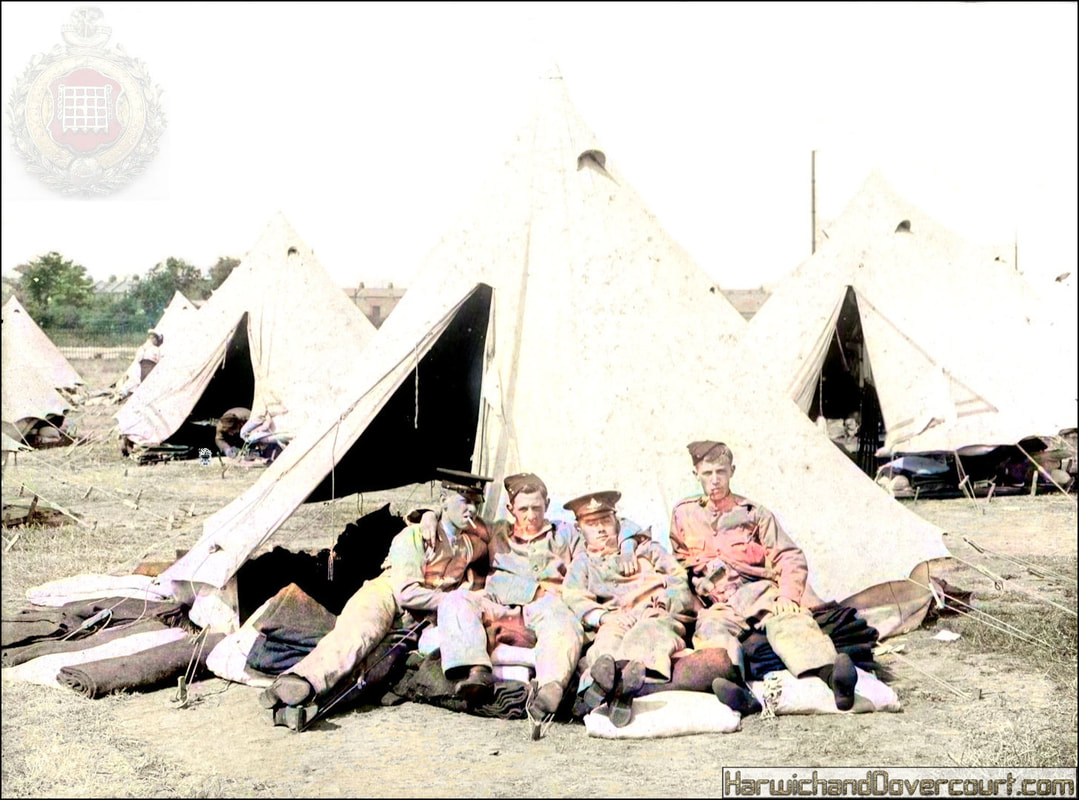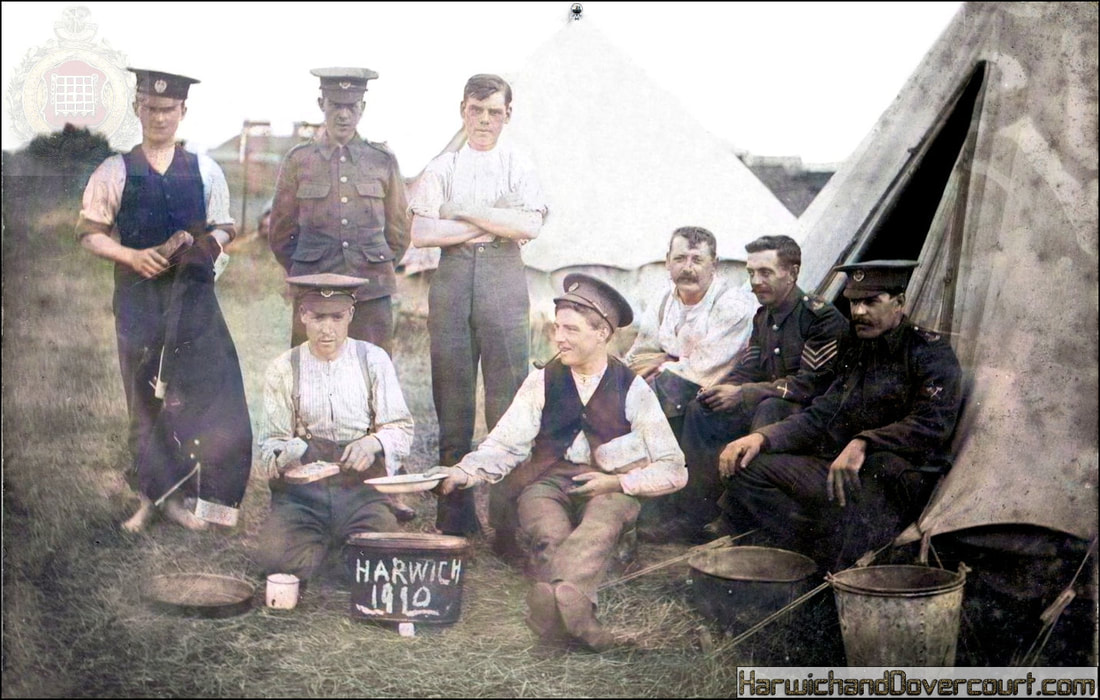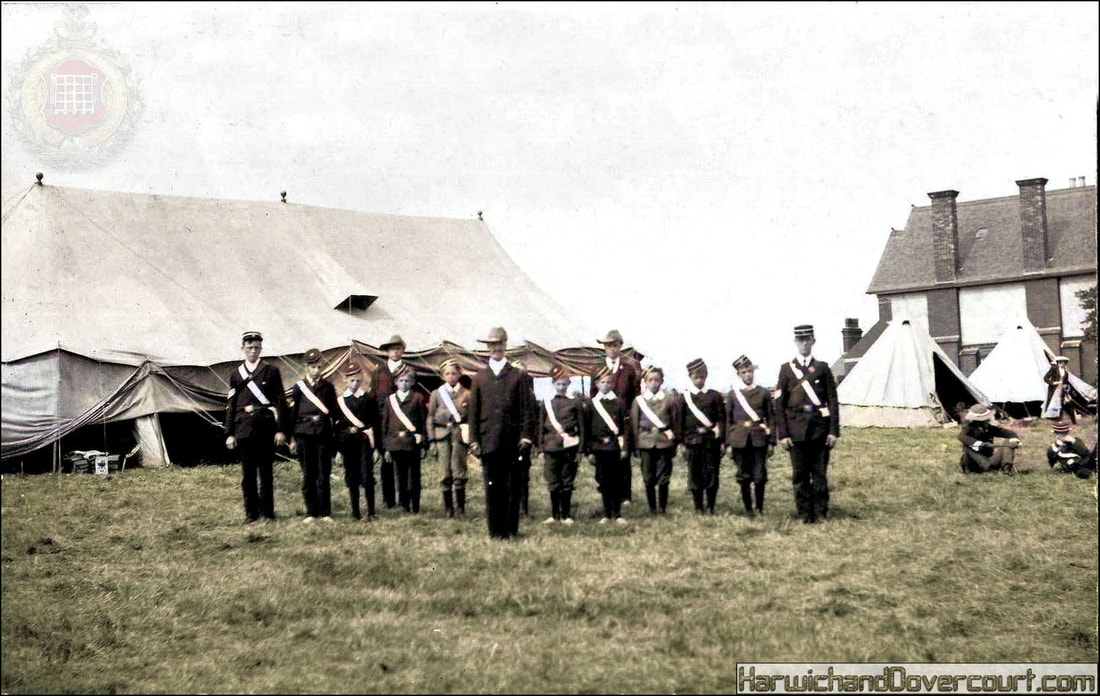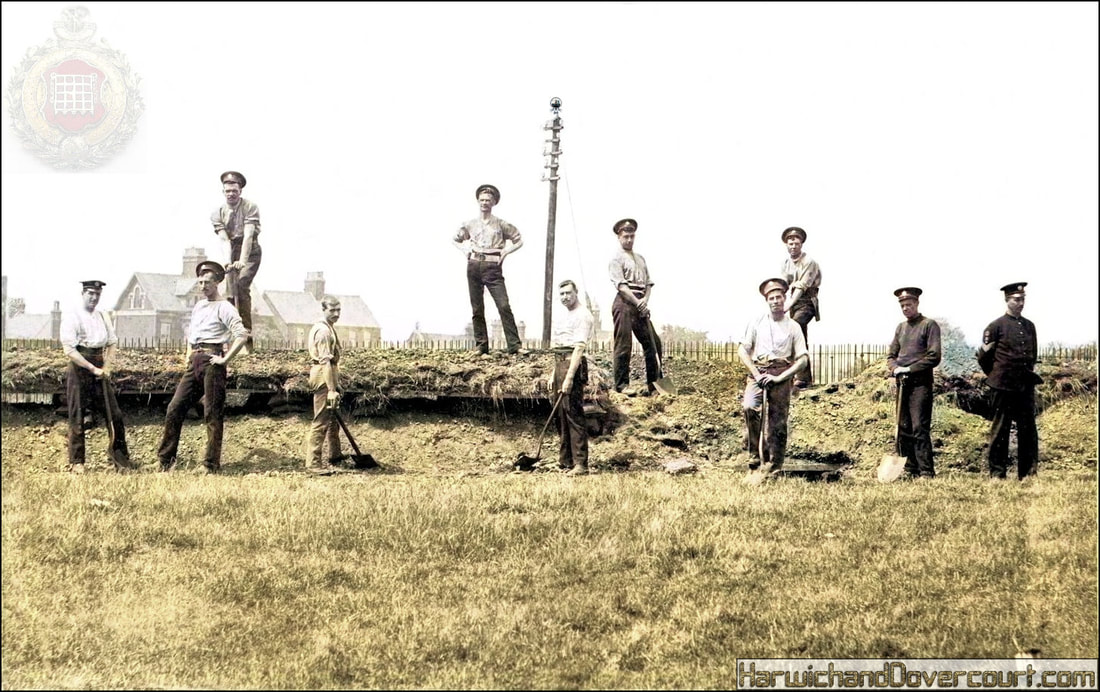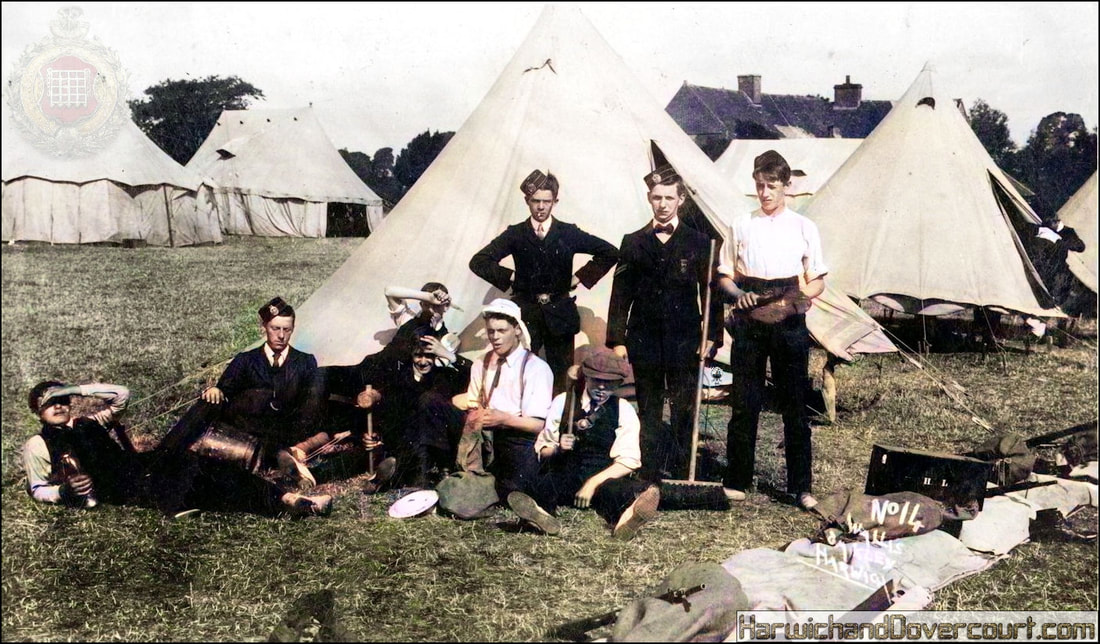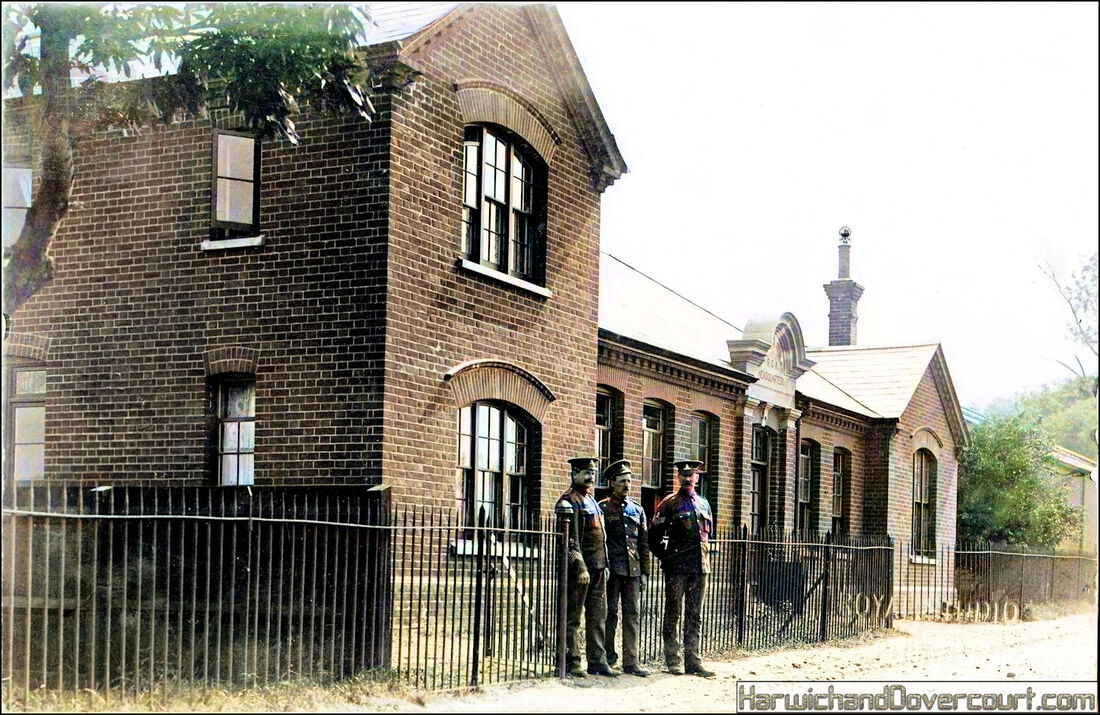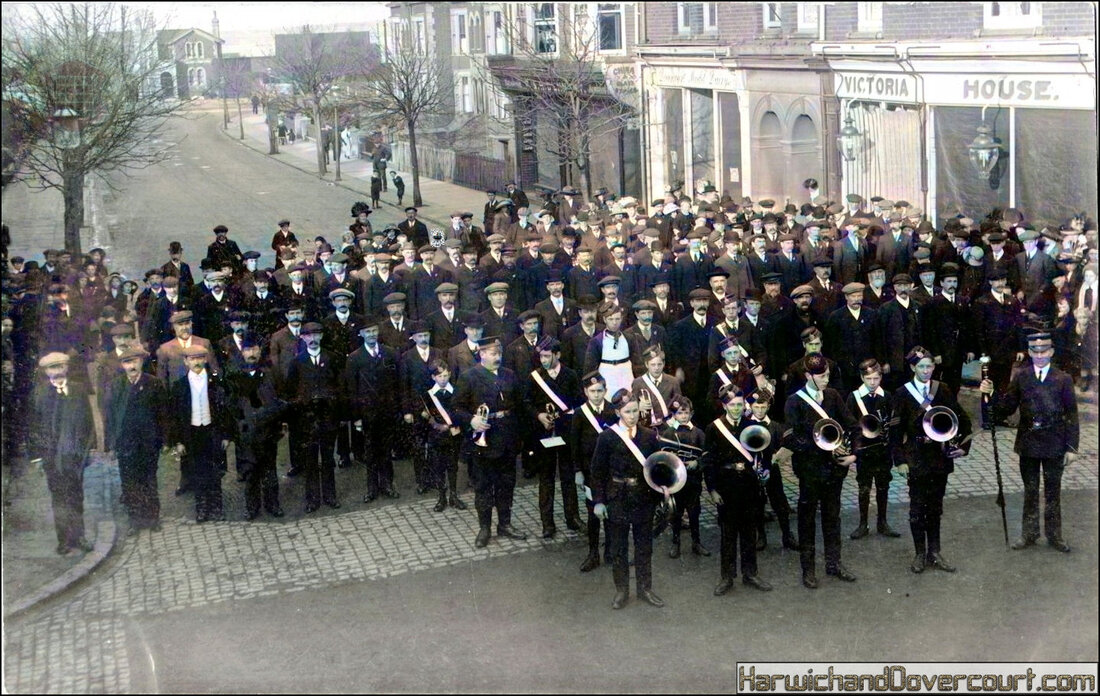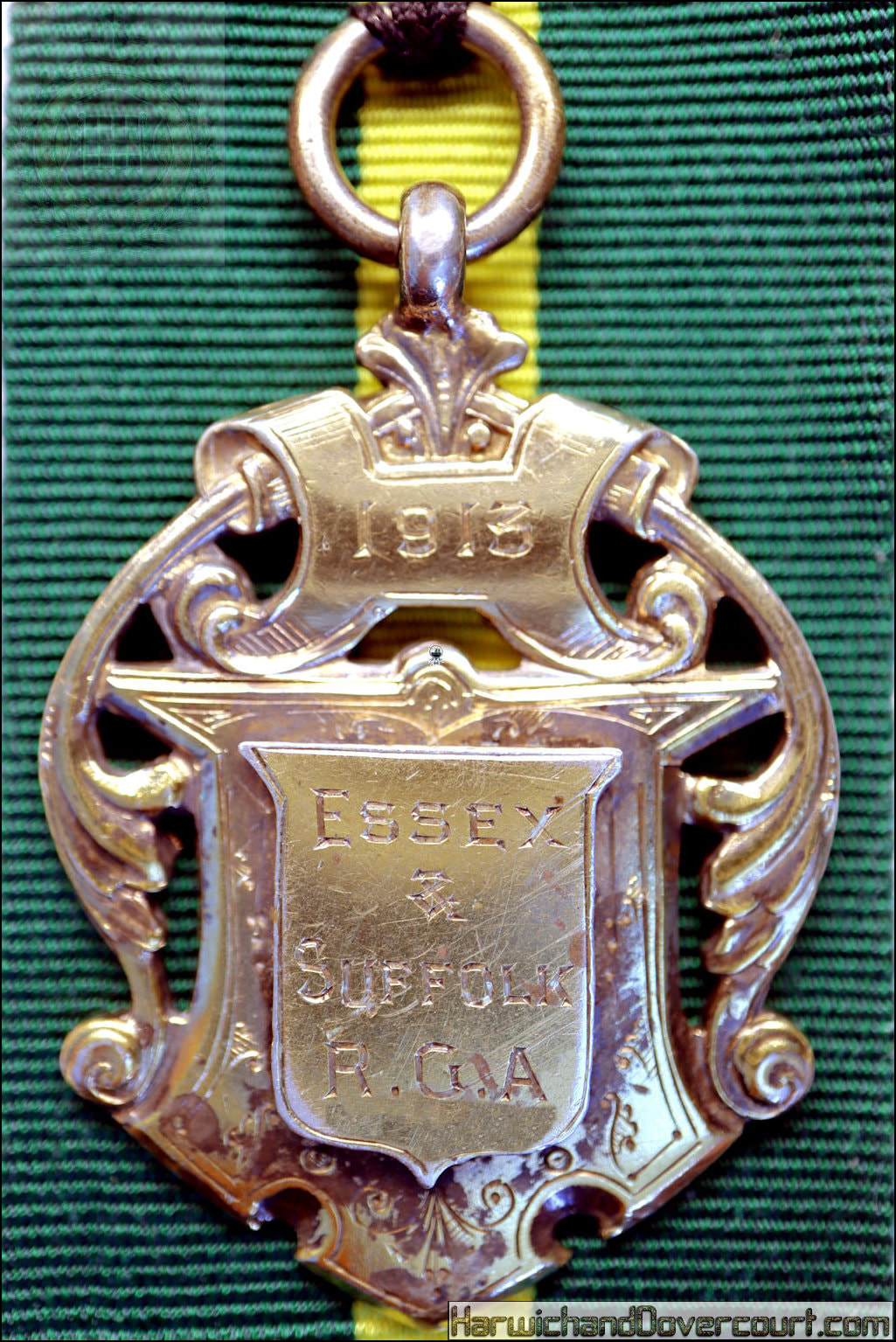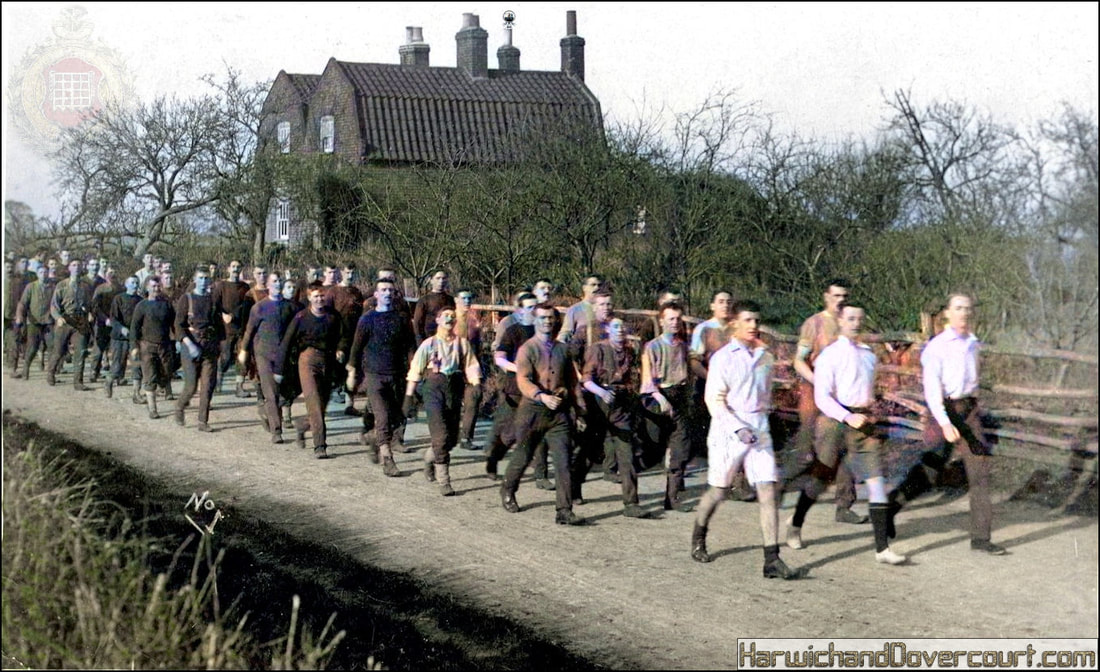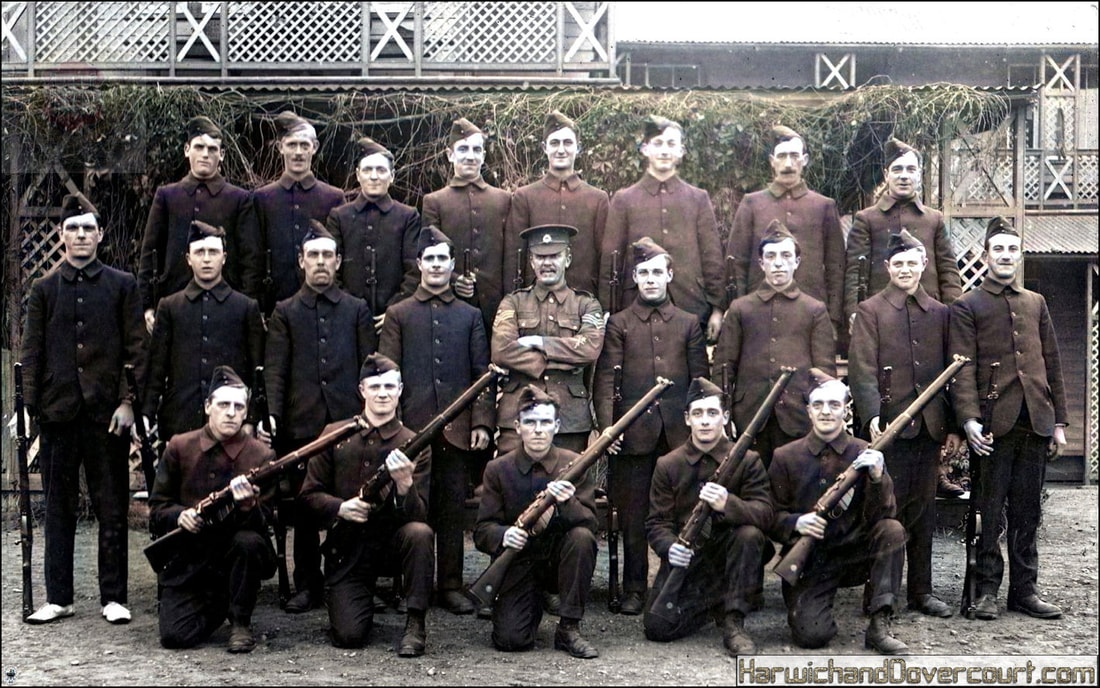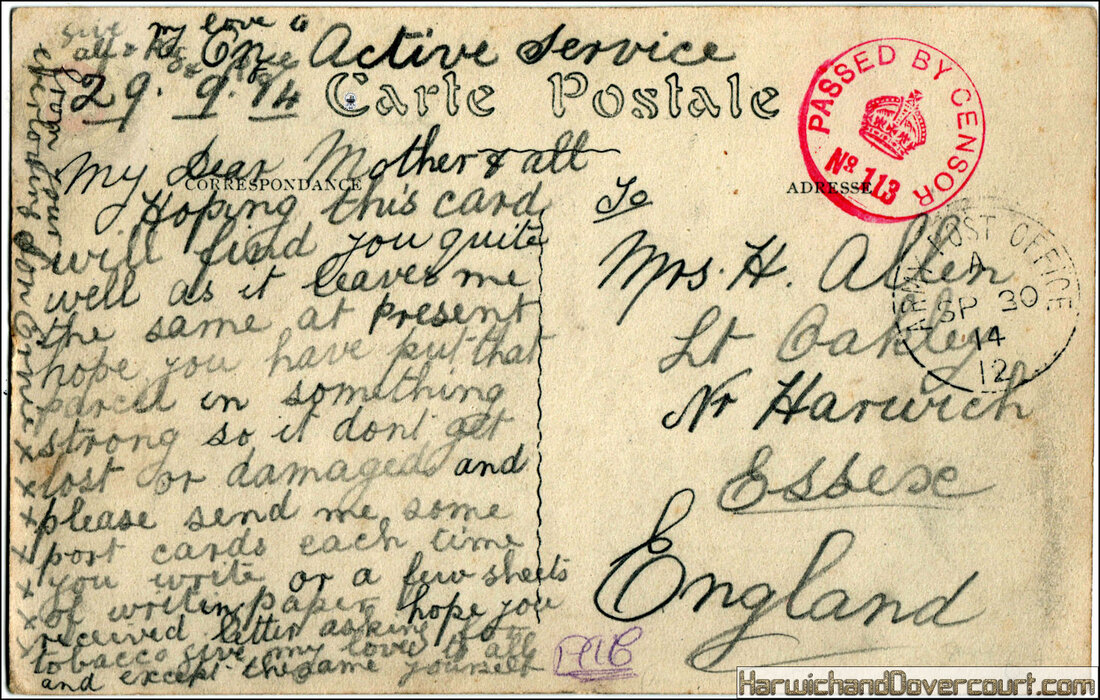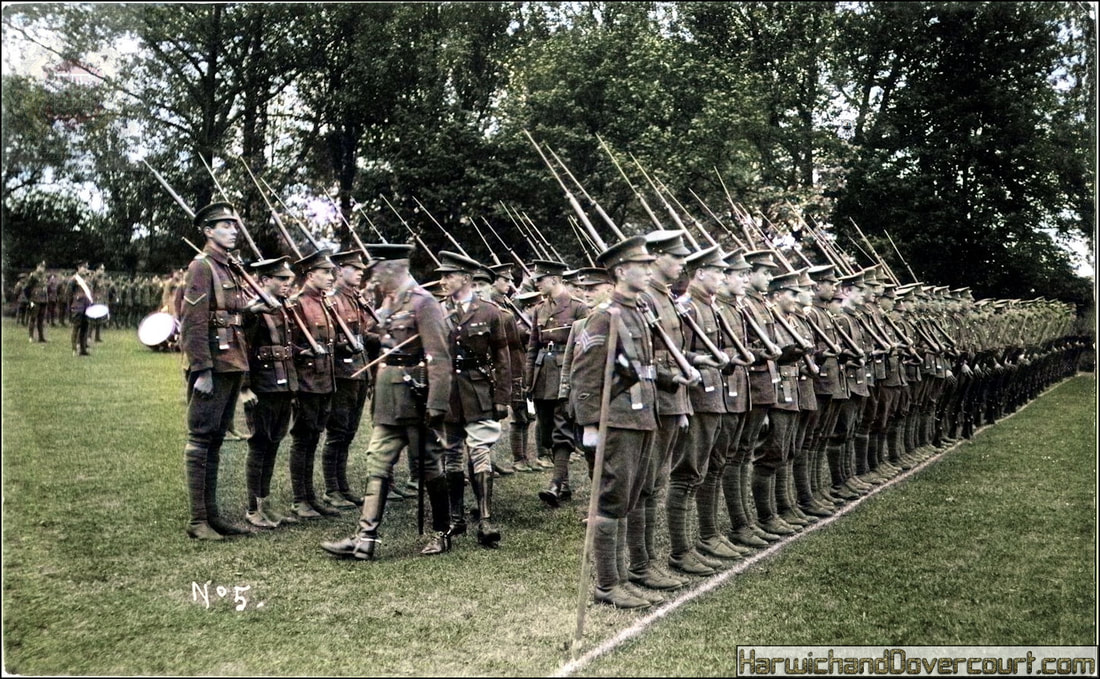Camping & Training
1884 ~ Barrack Lane Firing Range, Dovercourt, Essex H&D
~ Note : Cliffe House the home of John Bagshaw, built in 1845 in the background ~
The Royal Garrison Artillery
Target Practice "Firing Out To Sea" from Barrack Field (1884).
Photo by T.Sutcliffe, Studios, Dovercourt
Target Practice "Firing Out To Sea" from Barrack Field (1884).
Photo by T.Sutcliffe, Studios, Dovercourt
1901 ~ Harwich Camp, Barrack Field, Dovercourt (B.R.E.) H&D FW
1902 ~ The Band 1st Suffolk & Harwich Artillery Volunteers
~ From 1st June 1899 all the volunteer artillery units were part of the Royal Garrison Artillery ~
1905 ~ #02 The Camp. Ramsey (--) H&D FW
1905 ~ #10 Church Parade, Ramsey Camp (--) H&D FW
~1907 ~ "Brother's in arms" at Harwich Camp, Essex H&D ~
1910 ~ Army Camp Canteen at Harwich, Essex (--) H&D FW
1910 ~ Boys Brigade, Dovercourt (--) H&D FW
1910 ~ Ipswich Boys Brigade Camp At Dovercourt (--) H&D FW
1910 ~ The Army working at Harwich (--) H&D FW
1911 ~ Army Camp, Dovercourt, Harwich (1911) Wallis FW
1911 ~ Essex and Suffolk Brigade, R.G.A. Head Quarters.
The new headquarters of the Essex and Suffolk Royal Garrison Artillery Territorial Force
The new headquarters of the Essex and Suffolk Royal Garrison Artillery Territorial Force [and No. 1 Co.] were a unit of the Territorial Force with their HQ in Main Road, Dovercourt in 1911 It was made up of :-
No 1 (Harwich and Felixstowe) Garrison Company.
No 2 (Stratford) Garrison Company.
No 3 (Southend-on-Sea and Leigh-on-Sea) Garrison Company.
No 4 (Ipswich) Garrison Company.
The HQ comprised of an adjutant’s office, armoury, orderly and recreation rooms, a drill hall 100 by 50 feet, miniature rifle range and quarters for the instructor. The Harwich Troop of a squadron, of Essex Yeomanry also had an armoury and drill here in 1914. The building is now used as part of the the Park Pavilion Social, CO12 3NS
The headquarters of the Essex and Suffolk R.G.A. housed the volunteers whom manned the guns at the Beacon Hill Fort with the 1st Essex Artillery Volunteers formed at Harwich on 18th February 1860 as a response to a French invasion threat. In 1899 the two batteries located at Harwich were moved to create a new Corps, designated as the 1st Suffolk and Harwich Artillery Volunteers.
In 1908 on the formation of the Territorial Force the 1st Essex became the 2nd East Anglian Brigade Royal Field Artillery (T.F.). This brigade comprised the 1st, 2nd and 3rd Batteries. Five batteries were combined with the 1st Suffolk and Harwich Artillery Volunteers to form the Essex and Suffolk Royal Garrison Artillery (T.F.). They became part of the Territorial Force in 1908 and served during the First and Second World Wars until amalgamated in 1956.
The Royal Garrison Artillery: developed from fortress-based artillery located on British coasts. From 1914 when the army possessed very little heavy artillery it grew into a very large component of the British forces. It was armed with heavy, large calibre guns and howitzers that were positioned some way behind the front line and had immense destructive power.
The new headquarters of the Essex and Suffolk Royal Garrison Artillery Territorial Force [and No. 1 Co.] were a unit of the Territorial Force with their HQ in Main Road, Dovercourt in 1911 It was made up of :-
No 1 (Harwich and Felixstowe) Garrison Company.
No 2 (Stratford) Garrison Company.
No 3 (Southend-on-Sea and Leigh-on-Sea) Garrison Company.
No 4 (Ipswich) Garrison Company.
The HQ comprised of an adjutant’s office, armoury, orderly and recreation rooms, a drill hall 100 by 50 feet, miniature rifle range and quarters for the instructor. The Harwich Troop of a squadron, of Essex Yeomanry also had an armoury and drill here in 1914. The building is now used as part of the the Park Pavilion Social, CO12 3NS
The headquarters of the Essex and Suffolk R.G.A. housed the volunteers whom manned the guns at the Beacon Hill Fort with the 1st Essex Artillery Volunteers formed at Harwich on 18th February 1860 as a response to a French invasion threat. In 1899 the two batteries located at Harwich were moved to create a new Corps, designated as the 1st Suffolk and Harwich Artillery Volunteers.
In 1908 on the formation of the Territorial Force the 1st Essex became the 2nd East Anglian Brigade Royal Field Artillery (T.F.). This brigade comprised the 1st, 2nd and 3rd Batteries. Five batteries were combined with the 1st Suffolk and Harwich Artillery Volunteers to form the Essex and Suffolk Royal Garrison Artillery (T.F.). They became part of the Territorial Force in 1908 and served during the First and Second World Wars until amalgamated in 1956.
The Royal Garrison Artillery: developed from fortress-based artillery located on British coasts. From 1914 when the army possessed very little heavy artillery it grew into a very large component of the British forces. It was armed with heavy, large calibre guns and howitzers that were positioned some way behind the front line and had immense destructive power.
1912 ~ The 1st parade of the H&D National Reserve, Oct 6th 1912.
~ Assembled at Station Road, Dovercourt Bay, Essex ~
First parade of the Harwich and Dovercourt National Reserve, October 6th 1912.
Assembled at the junction of Station Road and Dovercourt High Street.
Nearly 100 men mustered under Captain Tuffnell on this occasion and were led by the Church Lads Brigade Band as they marched to St. Nicholas Church. Within less than two years from this day, the outbreak of WW1 had begun (August 4th 1914).
In the background Dovercourt Station can be seen and visible at the rear of the gathering is Dennant's Fancy Store, next to which can be seen Sewell's Model Dairy and Victoria House which was the drapery shop of Agnes East.
Publisher of the postcard is unfortunately unknown.
Postcode for the nearest location is CO12 3LY
Assembled at the junction of Station Road and Dovercourt High Street.
Nearly 100 men mustered under Captain Tuffnell on this occasion and were led by the Church Lads Brigade Band as they marched to St. Nicholas Church. Within less than two years from this day, the outbreak of WW1 had begun (August 4th 1914).
In the background Dovercourt Station can be seen and visible at the rear of the gathering is Dennant's Fancy Store, next to which can be seen Sewell's Model Dairy and Victoria House which was the drapery shop of Agnes East.
Publisher of the postcard is unfortunately unknown.
Postcode for the nearest location is CO12 3LY
1913 ~ 1st Suffolk & Harwich Volunteer Artillery Prize Medal to Col Sgt Maj F J Keeble
1914 ~ 3rd (Reserve) Essex Battalion Military Training by Wallis H&D
~1914 ~ The 10th Bedfordshire Service Battalion, Dovercourt Bay H&D ~
~ Photo taken in the Retreat, Low Road, Dovercourt Bay ~
The 10th (Service) Battalion of the Bedfordshire Reserves at the Retreat, Dovercourt, Essex in November 1914
This Military card at the start of World War One, shows troops billeted at Greys Retreat opposite the Dovercourt Light houses near Beach Road. There were several retreats in Essex as far away as Epping Forest, which provided entertainment and refreshments for day trippers.
The arrival of the railway in Dovercourt, made it easier for many more people to visit the retreats. The size of the refreshment hall shows how they could cope with hundreds of people at a time. The retreats often were not that popular with local people owing to the noise and mess created by the huge numbers of people visiting them.
The seaside retreats opened by the Riggs family included the Dovercourt Retreat built in 1889, which was later sold in 1892 to W.F. and H.Gray, who lived and raised their families there until 1906 when W.F.Gray moved from Dovercourt and took over another retreat at Theydon Bois. Despite the move, the Grays retained an interest in the Dovercourt business which as a limited liability company continued trading until 1959. An entry in the Herts and Essex Trades Directory for 1958-9 gives the information that as a restaurant and café at the Lower Marine Parade the firm was still operating. Shortly afterwards it went into liquidation and the site was purchased by the local Council.
Gray's 'Temperance' Retreat composed of two storeys could accommodate 2,000 people, it was a predominantly wooden construction with a tea, rooms, restaurant, and a dance floor. School and Church outings were common, with groups of children sleeping in the long dormitories. In both World Wars it was requisitioned as billets for soldiers and then fell into disrepair before being demolished in the 1950s.
This photographic postcard of a Sergeant with his section serving with the 10th Battalion, Bedfordshire Regiment, wearing Kitchener's Blues, was produced by F.G. Steggles, photographers based at Dovercourt.
The 10th (Service) Battalion was raised in November 1914 as a part of Lord Kitchener's K4 Army Group, within the 106th Brigade, 35th Division. It remained in England as a 'Reserve' battalion, being based at Dovercourt from its formation and moving to White City in January 1915. In May 1915 they moved to Colchester, then back to Dovercourt in March 1916. The battalion was redesignated as the 27th Battalion of the newly formed Training Reserve in September 1916.
This Military card at the start of World War One, shows troops billeted at Greys Retreat opposite the Dovercourt Light houses near Beach Road. There were several retreats in Essex as far away as Epping Forest, which provided entertainment and refreshments for day trippers.
The arrival of the railway in Dovercourt, made it easier for many more people to visit the retreats. The size of the refreshment hall shows how they could cope with hundreds of people at a time. The retreats often were not that popular with local people owing to the noise and mess created by the huge numbers of people visiting them.
The seaside retreats opened by the Riggs family included the Dovercourt Retreat built in 1889, which was later sold in 1892 to W.F. and H.Gray, who lived and raised their families there until 1906 when W.F.Gray moved from Dovercourt and took over another retreat at Theydon Bois. Despite the move, the Grays retained an interest in the Dovercourt business which as a limited liability company continued trading until 1959. An entry in the Herts and Essex Trades Directory for 1958-9 gives the information that as a restaurant and café at the Lower Marine Parade the firm was still operating. Shortly afterwards it went into liquidation and the site was purchased by the local Council.
Gray's 'Temperance' Retreat composed of two storeys could accommodate 2,000 people, it was a predominantly wooden construction with a tea, rooms, restaurant, and a dance floor. School and Church outings were common, with groups of children sleeping in the long dormitories. In both World Wars it was requisitioned as billets for soldiers and then fell into disrepair before being demolished in the 1950s.
This photographic postcard of a Sergeant with his section serving with the 10th Battalion, Bedfordshire Regiment, wearing Kitchener's Blues, was produced by F.G. Steggles, photographers based at Dovercourt.
The 10th (Service) Battalion was raised in November 1914 as a part of Lord Kitchener's K4 Army Group, within the 106th Brigade, 35th Division. It remained in England as a 'Reserve' battalion, being based at Dovercourt from its formation and moving to White City in January 1915. In May 1915 they moved to Colchester, then back to Dovercourt in March 1916. The battalion was redesignated as the 27th Battalion of the newly formed Training Reserve in September 1916.
1914 ~ Beacon Hill Battery Xmas (First Christmas of WW1) H&D 01 FW
1914 ~ Church of Saint-Étienne, Brie-Comte-Robert H&D FWW
~ 1914 ~ No 5 On Parade, at Cliffe Park, Dovercourt Bay, Essex, Photo by F.Wallis ~
~ Just prior to the outbreak of WW1 in August ~
"On Parade" with top brass in attendance at Cliffe Park, Dovercourt in 1914, photo by F.Wallis.
Harwich and Dovercourt was bristling with activity during the first world war (1914 - 1918), this photograph taken in Cliffe Park in 1914, shows the a full military parade, with inspection from senior officers. I like the fact that the tallest Lance Corporal was the right-hand marker, he dwarfs the other men, impressive, but not such an attribute in battle.
The sacrifice made by all military personnel across the world, was humbling and should never be forgotten.
Harwich and Dovercourt was bristling with activity during the first world war (1914 - 1918), this photograph taken in Cliffe Park in 1914, shows the a full military parade, with inspection from senior officers. I like the fact that the tallest Lance Corporal was the right-hand marker, he dwarfs the other men, impressive, but not such an attribute in battle.
The sacrifice made by all military personnel across the world, was humbling and should never be forgotten.
